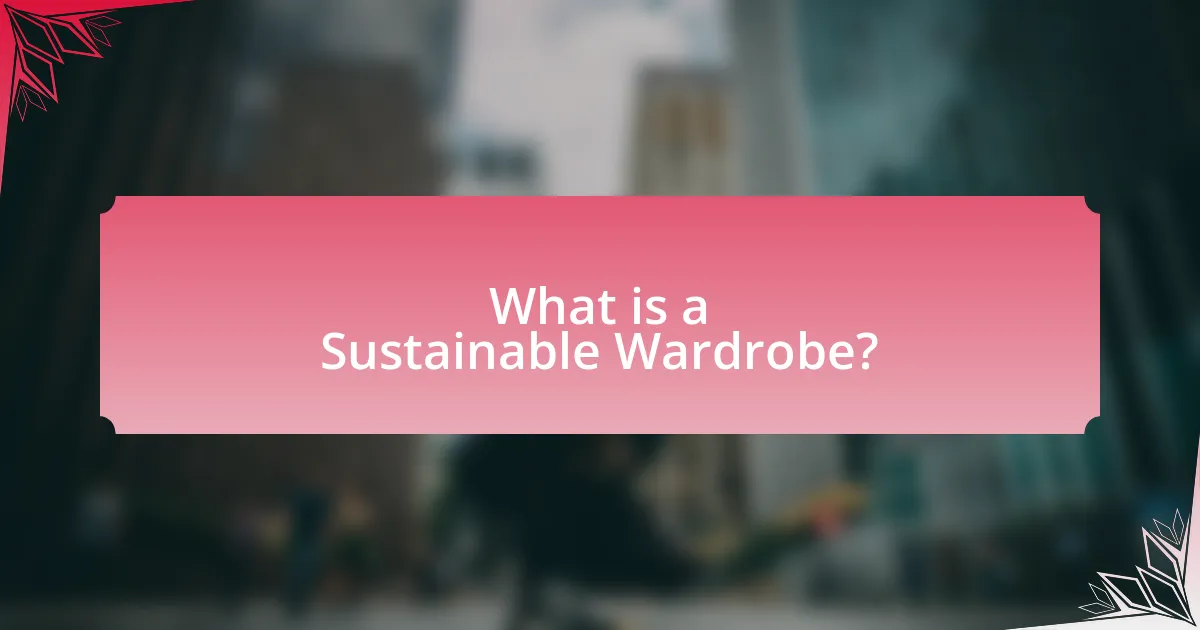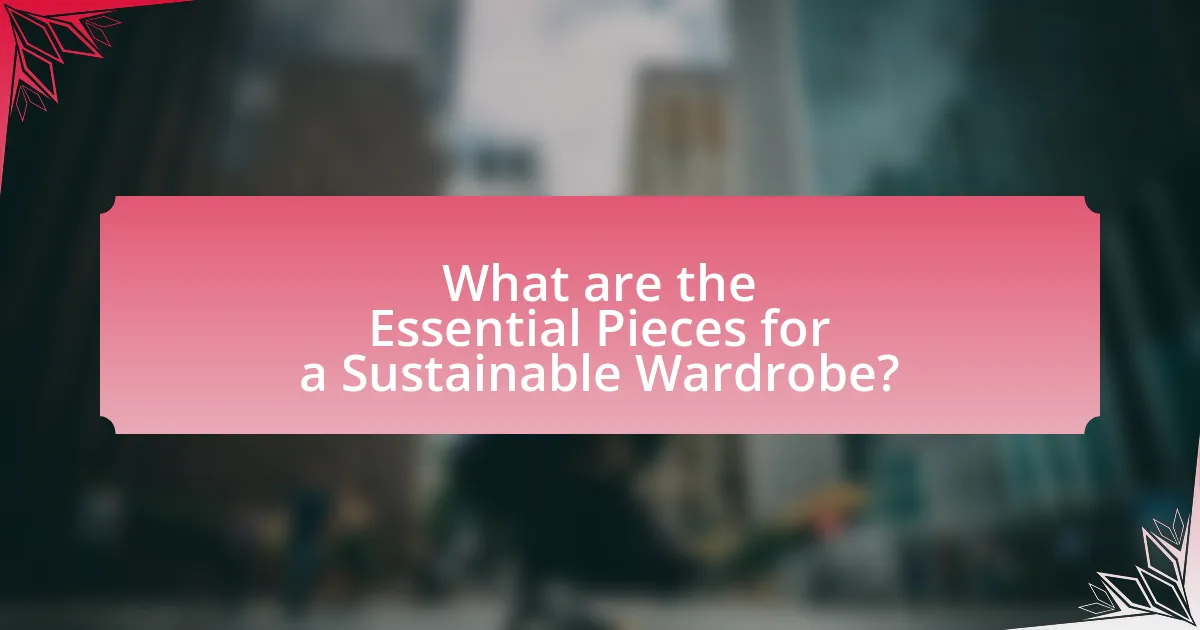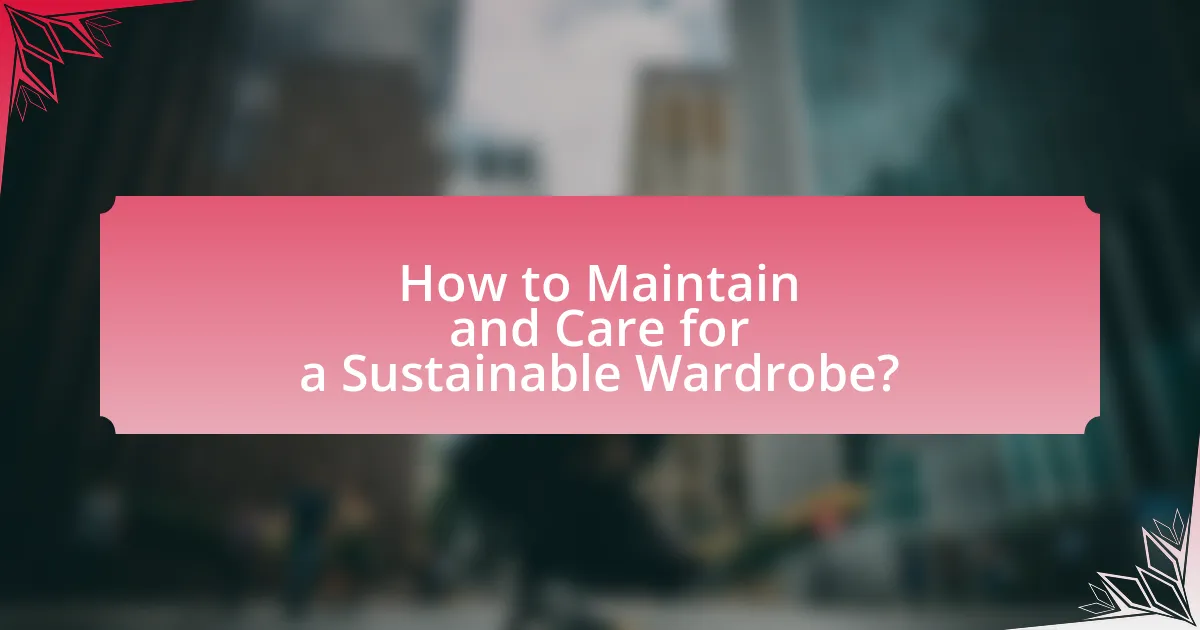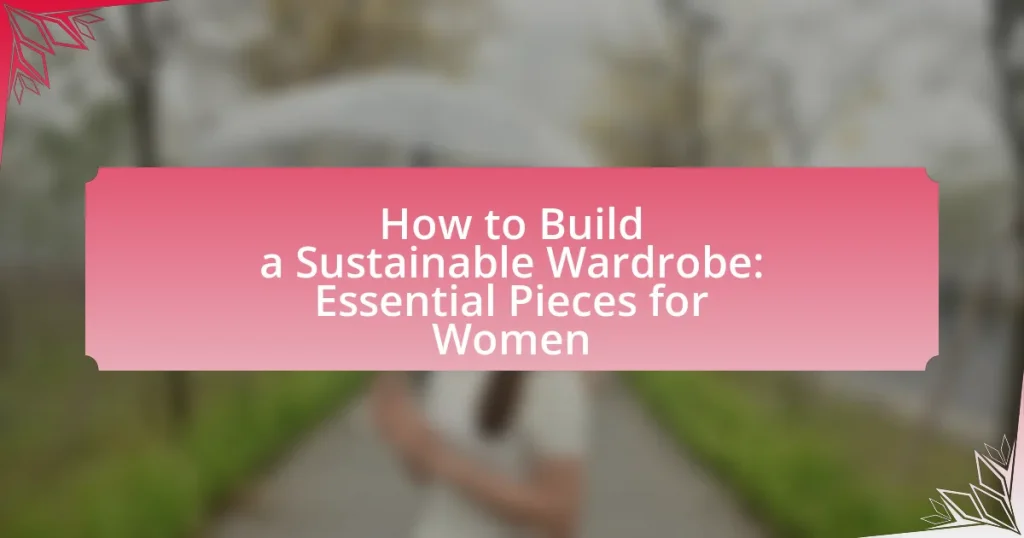A sustainable wardrobe is a collection of clothing and accessories that are ethically sourced, environmentally friendly, and designed for longevity. This article outlines the importance of sustainability in fashion, highlighting the environmental and ethical implications of clothing production, particularly in relation to fast fashion. It details how to build a sustainable wardrobe by prioritizing quality over quantity, selecting versatile pieces, and choosing eco-friendly materials. Additionally, the article provides practical tips for assessing brand sustainability, maintaining garments, and making mindful purchasing decisions, ultimately promoting a more responsible fashion ecosystem for women.

What is a Sustainable Wardrobe?
A sustainable wardrobe is a collection of clothing and accessories that are ethically sourced, environmentally friendly, and designed to last. This concept emphasizes the use of materials that minimize environmental impact, such as organic cotton, recycled fabrics, and sustainable production practices. According to the Global Fashion Agenda’s 2021 report, the fashion industry is responsible for 10% of global carbon emissions, highlighting the importance of sustainable choices in reducing this footprint. By prioritizing quality over quantity and supporting brands that adhere to sustainable practices, individuals can contribute to a more responsible fashion ecosystem.
Why is sustainability important in fashion?
Sustainability is important in fashion because it addresses environmental degradation, social inequality, and economic viability within the industry. The fashion industry is responsible for approximately 10% of global carbon emissions and significant water pollution, making sustainable practices essential for reducing its ecological footprint. Furthermore, sustainable fashion promotes ethical labor practices, ensuring fair wages and safe working conditions for garment workers. By prioritizing sustainability, the fashion industry can contribute to a healthier planet and a more equitable society, ultimately fostering long-term viability for businesses and communities alike.
How does fast fashion impact the environment?
Fast fashion significantly harms the environment by contributing to pollution, waste, and resource depletion. The production processes of fast fashion brands often involve toxic chemicals, which can contaminate water sources and harm ecosystems. For instance, the fashion industry is responsible for 20% of global wastewater, primarily due to dyeing and finishing processes. Additionally, fast fashion encourages a throwaway culture, leading to approximately 92 million tons of textile waste generated annually, much of which ends up in landfills. Furthermore, the rapid production cycles require vast amounts of water; it takes about 2,700 liters of water to produce a single cotton t-shirt, exacerbating water scarcity issues. These factors collectively illustrate the detrimental environmental impact of fast fashion.
What are the ethical implications of clothing production?
The ethical implications of clothing production include labor exploitation, environmental degradation, and animal welfare concerns. Labor exploitation is evident in the fast fashion industry, where workers often endure poor working conditions, long hours, and low wages; for instance, the International Labour Organization reports that over 170 million children are engaged in child labor in various sectors, including textiles. Environmental degradation arises from the excessive use of water, chemicals, and energy in garment manufacturing, contributing to pollution and resource depletion; the fashion industry is responsible for 10% of global carbon emissions, according to the United Nations Environment Programme. Additionally, animal welfare issues are raised in the production of materials like leather and wool, where animals may be subjected to inhumane treatment. These factors collectively highlight the need for ethical considerations in clothing production to promote sustainability and social responsibility.
What defines a sustainable wardrobe?
A sustainable wardrobe is defined by its focus on environmentally friendly practices, ethical production, and longevity of clothing. This includes selecting garments made from organic or recycled materials, supporting brands that prioritize fair labor practices, and choosing timeless styles that reduce the need for frequent replacements. Research indicates that the fashion industry is responsible for approximately 10% of global carbon emissions, highlighting the importance of sustainable choices in reducing environmental impact. By prioritizing these elements, individuals can contribute to a more sustainable fashion ecosystem.
What materials are considered sustainable?
Sustainable materials include organic cotton, hemp, Tencel, recycled polyester, and bamboo. Organic cotton is grown without synthetic pesticides or fertilizers, reducing environmental impact. Hemp requires minimal water and no pesticides, making it a highly sustainable crop. Tencel, made from sustainably sourced wood pulp, is produced in a closed-loop process that recycles water and solvents. Recycled polyester, derived from post-consumer plastic bottles, diverts waste from landfills and reduces the need for virgin materials. Bamboo grows rapidly and requires little water, making it an eco-friendly option. These materials contribute to a more sustainable wardrobe by minimizing environmental harm and promoting responsible sourcing practices.
How can one assess the sustainability of a clothing brand?
To assess the sustainability of a clothing brand, one should evaluate its practices regarding materials, production processes, and labor conditions. Sustainable brands typically use organic or recycled materials, employ eco-friendly manufacturing techniques, and ensure fair labor practices. For instance, brands that are certified by organizations like Global Organic Textile Standard (GOTS) or Fair Trade demonstrate a commitment to sustainability through rigorous standards. Additionally, transparency in supply chains and a clear commitment to reducing carbon footprints further indicate a brand’s sustainability.

What are the Essential Pieces for a Sustainable Wardrobe?
Essential pieces for a sustainable wardrobe include high-quality basics, versatile layering items, and eco-friendly accessories. High-quality basics such as organic cotton t-shirts, ethically produced jeans, and timeless dresses form the foundation of a sustainable wardrobe, as they are durable and reduce the need for frequent replacements. Versatile layering items like cardigans, blazers, and lightweight jackets enhance outfit combinations while promoting longevity. Eco-friendly accessories, including bags made from recycled materials and sustainable footwear, complement the wardrobe while minimizing environmental impact. These choices collectively support sustainability by prioritizing quality, versatility, and ethical production practices.
What key items should every woman include in her sustainable wardrobe?
Every woman should include versatile basics, eco-friendly fabrics, and timeless pieces in her sustainable wardrobe. Versatile basics such as organic cotton t-shirts and well-fitted jeans can be mixed and matched for various occasions, reducing the need for excessive clothing. Eco-friendly fabrics like Tencel, hemp, and recycled polyester minimize environmental impact during production. Timeless pieces, including a classic blazer and a little black dress, ensure longevity in style and usage, promoting a sustainable approach to fashion. According to the Ellen MacArthur Foundation, extending the life of clothing by just nine months can reduce carbon, water, and waste footprints by 20-30%.
How do versatile pieces contribute to sustainability?
Versatile pieces contribute to sustainability by reducing the need for excessive clothing purchases, thereby minimizing waste and resource consumption. When clothing items can be styled in multiple ways or serve various functions, consumers are less likely to buy additional items, which leads to a decrease in textile waste. According to the Ellen MacArthur Foundation, the fashion industry is responsible for 92 million tons of waste annually, and promoting versatile clothing can significantly mitigate this issue by encouraging a more mindful approach to consumption.
What are the benefits of investing in quality over quantity?
Investing in quality over quantity leads to a more sustainable wardrobe, as high-quality items tend to last longer and require less frequent replacement. This longevity reduces waste and the environmental impact associated with fast fashion, which contributes to significant textile waste—approximately 92 million tons annually according to the United Nations. Additionally, quality garments often feature better craftsmanship and materials, enhancing comfort and style, which can lead to increased satisfaction and reduced impulse buying. Therefore, prioritizing quality supports both personal and environmental sustainability.
How can one choose sustainable alternatives for common clothing items?
To choose sustainable alternatives for common clothing items, one should prioritize materials that are eco-friendly, such as organic cotton, Tencel, or recycled polyester. These materials reduce environmental impact by minimizing water usage, chemical exposure, and waste. For instance, organic cotton uses 91% less water than conventional cotton and avoids harmful pesticides, making it a more sustainable choice. Additionally, consumers can look for certifications like GOTS (Global Organic Textile Standard) or OEKO-TEX, which ensure that the clothing meets specific environmental and social criteria. By selecting brands that emphasize transparency in their supply chains and ethical labor practices, individuals can further support sustainability in fashion.
What are the best sustainable options for everyday wear?
The best sustainable options for everyday wear include organic cotton clothing, Tencel garments, and recycled polyester items. Organic cotton is grown without harmful pesticides and uses less water than conventional cotton, making it an eco-friendly choice. Tencel, made from sustainably sourced wood pulp, is biodegradable and produced in a closed-loop process that minimizes waste. Recycled polyester, derived from post-consumer plastic bottles, reduces landfill waste and conserves resources compared to virgin polyester production. These materials not only support sustainable practices but also offer comfort and durability for daily use.
How can second-hand shopping support a sustainable wardrobe?
Second-hand shopping supports a sustainable wardrobe by reducing the demand for new clothing production, which is resource-intensive and contributes to environmental degradation. By purchasing pre-owned items, consumers extend the lifecycle of garments, thereby minimizing waste and lowering carbon emissions associated with manufacturing and transportation. According to a report by the Ellen MacArthur Foundation, extending the life of clothing by just nine months can reduce carbon, water, and waste footprints by 20-30%. This practice not only promotes environmental sustainability but also encourages a circular economy, where clothing is reused and recycled rather than discarded.

How to Maintain and Care for a Sustainable Wardrobe?
To maintain and care for a sustainable wardrobe, prioritize proper washing, drying, and storage techniques. Washing clothes in cold water reduces energy consumption and prevents fabric damage, while air drying minimizes the use of electricity and extends garment life. Additionally, storing clothes in a cool, dry place prevents mold and mildew, preserving their quality. Regularly repairing minor damages, such as sewing loose buttons or fixing small tears, further extends the lifespan of garments, reducing the need for new purchases. According to the Ellen MacArthur Foundation, extending the life of clothing by just nine months can reduce carbon, water, and waste footprints by 20-30%.
What practices can extend the life of clothing?
To extend the life of clothing, practices such as proper washing, drying, and storage should be implemented. Washing clothes in cold water reduces energy consumption and minimizes fabric wear, while air drying prevents shrinkage and damage from high heat. Additionally, storing garments in a cool, dry place and using padded hangers for delicate items helps maintain their shape and integrity. According to the Environmental Protection Agency, reducing the frequency of washing can significantly decrease the environmental impact and prolong the lifespan of textiles.
How does proper washing and drying affect garment longevity?
Proper washing and drying significantly enhances garment longevity by preventing fabric damage and maintaining structural integrity. When garments are washed according to care labels, using appropriate water temperatures and detergents, the risk of fading, shrinking, and wear is minimized. For instance, washing in cold water can reduce energy consumption and prevent color loss, while air drying instead of using a dryer can prevent heat damage, which is known to degrade fibers over time. Studies indicate that garments washed and dried correctly can last up to 50% longer than those subjected to improper care, thus contributing to a more sustainable wardrobe.
What are the best ways to repair and upcycle clothing?
The best ways to repair and upcycle clothing include sewing patches on damaged areas, using fabric dye to refresh colors, and transforming garments into new items, such as turning a dress into a top. Sewing patches effectively covers holes and adds a unique design element, while fabric dye can rejuvenate faded clothing, extending its life. Transforming garments not only reduces waste but also allows for creativity in fashion, as seen in the trend of converting old jeans into bags or skirts. These methods contribute to sustainability by minimizing textile waste and promoting a circular fashion economy.
What are some tips for organizing a sustainable wardrobe?
To organize a sustainable wardrobe, prioritize quality over quantity by selecting versatile, durable pieces made from eco-friendly materials. This approach reduces waste and encourages mindful consumption. Additionally, implement a system for decluttering regularly, such as the “one in, one out” rule, which helps maintain a manageable collection while promoting sustainability. Research indicates that the fashion industry contributes significantly to environmental degradation, with the Ellen MacArthur Foundation reporting that clothing production has doubled in the last 15 years, leading to increased waste. By focusing on these strategies, individuals can create a wardrobe that is both sustainable and functional.
How can one effectively declutter while maintaining sustainability?
To effectively declutter while maintaining sustainability, one should prioritize donating or recycling items instead of discarding them. This approach not only reduces waste but also supports local charities and promotes a circular economy. For instance, organizations like Goodwill and Habitat for Humanity accept clothing and household items, ensuring they are reused or repurposed. Additionally, utilizing online platforms for selling or swapping items can extend the lifecycle of products, further minimizing environmental impact. Research indicates that the fashion industry contributes significantly to landfill waste, with approximately 92 million tons of textile waste generated annually, highlighting the importance of sustainable decluttering practices.
What strategies can help in making mindful purchasing decisions?
To make mindful purchasing decisions, individuals should adopt strategies such as creating a shopping list, evaluating needs versus wants, and researching products before buying. Creating a shopping list helps prioritize essential items, reducing impulse purchases. Evaluating needs versus wants encourages consumers to reflect on the necessity of an item, promoting thoughtful choices. Researching products, including their sustainability and ethical production practices, informs consumers about the impact of their purchases, leading to more responsible decisions. Studies indicate that consumers who engage in these strategies are more likely to make sustainable choices, contributing to a reduced environmental footprint.
What are the best practices for building a sustainable wardrobe?
The best practices for building a sustainable wardrobe include prioritizing quality over quantity, choosing versatile pieces, and opting for eco-friendly materials. Prioritizing quality ensures that clothing lasts longer, reducing the need for frequent replacements; for example, garments made from organic cotton or recycled materials often have a lower environmental impact. Choosing versatile pieces allows for multiple outfit combinations, minimizing the total number of items needed. Additionally, supporting ethical brands that practice fair labor and sustainable production methods contributes to a more responsible fashion industry. According to a report by the Ellen MacArthur Foundation, extending the life of clothing by just nine months can reduce carbon, water, and waste footprints by around 20-30%.














